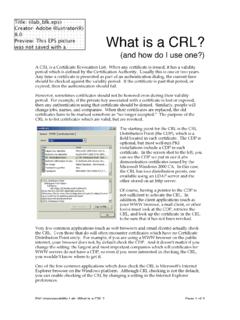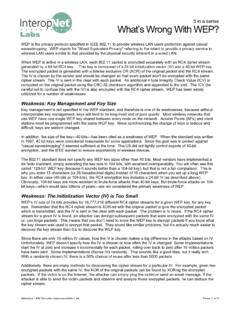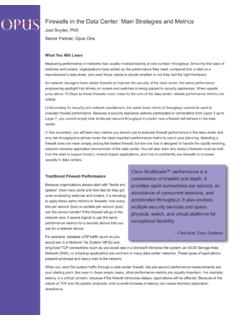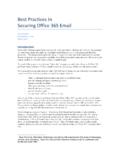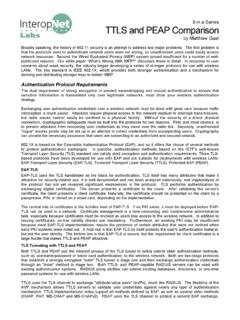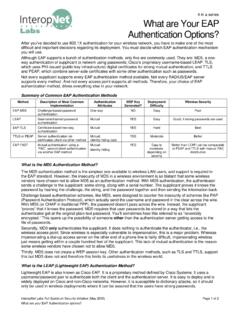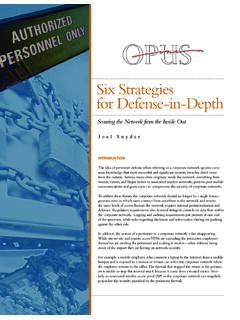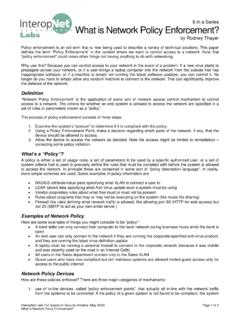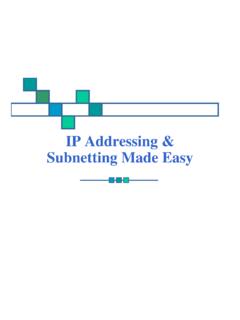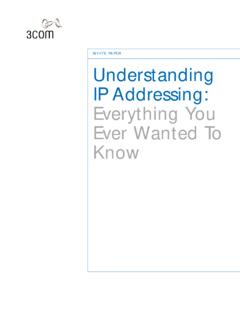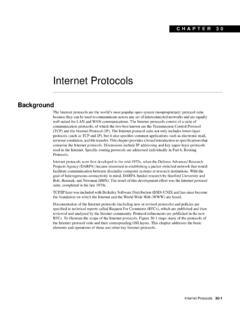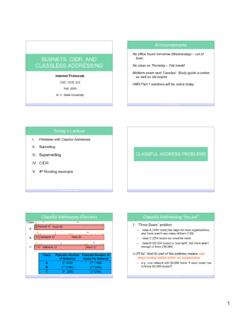Transcription of TCP/IP Addressing and Subnetting an excerpt from: A ...
1 TCP/IP Addressing andTCP/IP Addressing andSubnettingSubnettingan excerpt from: an excerpt from: A Technical Introduction toA Technical Introduction toTCP/IP InternalsTCP/IP InternalsPresentation Copyright 1995 TGV Software, 2IP Addressing RoadmapFormat of IP AddressesTraditional Class NetworksNetwork MasksSubnettingSupernettingSpecial IP AddressesSlide 3IP AddressesAll IP interfaces have IP addressesEach IP interface must have its own uniqueIP addressInternally, this is represented as a 32-bitnumber of 0 s and 1 sIP addresses consist of two partsnetwork identificationhost identificationSlide 4 Breaking it up into networknumber and host is keyNetwork PartHost Part32 bits1-30 bits2-31 bitsSlide 5We care because that show we do routingIP routing is based on a simple next hop model:Is the destination address ON my network orNOT?
2 If it is ON my network, send it directlyIf it is NOT on my network, send it via a routerTo match network numbers, you must knowwhat part is network and what part is hostSlide 6 Representing IP AddressesThere are several ways the IP address canbe represented32 bit number of 0 s and 1 s10100001 00101100 11000000 00000001four decimal numbers separated by 7 Traditional Network ClassAddressesThe first dotted quad value identifies thenetwork class and how much of the IPaddress is the network identifierClass A Networks (first number between 1-127)Class B Networks (first number between 128-191)
3 Class C Networks (first number between 192-223)There are also some special IP addresseswhich are defined in a different wayClass D Networks (first number between 224-239)for IP multicastClass E Networks (first number between 240-255)for Landmark routingSlide 8 This is due to a clever hackby the IP authors010011 Class A AddressNetwork = 8 bitsHost = 24 bitsClass B AddressNetwork = 16 bitsHost = 16 bitsClass C AddressNetwork = 24 bitsHost = 8 bitsSlide 9 Assigning NetworkNumbersNetwork numbers imply some space forhostsNetwork numbers are assigned by your InternetService Provider, who got them from theInterNIC (Network Information Center)Network numbers are written as a full 32-bitquantity (and an implied network mask)
4 Networks end with some number ofcontiguous zero-bits on the rightThese zero-bits are where customers canuse one bits for host addressesSlide 10 You can also use RFC1597 addressesFor local use, although your provider mayreserve some of - (10/8) - ( ) - ( )(see also RFC 1918 and RFC 1627)Slide 11 Network MaskIdentifies how many bits of the IP addressthe host may useThe mask contains a 1 bit for every bit in the network portion of the addressThe mask contains a 0 bit for every bit in the host portion of the addressEvery host on a network must have thesame network maskMay also be called the Subnet MaskSlide 12 Default Network Masks32 bit Network AddressClass ANetwork PortionHost 13 Network Masks are nowshown with slash notationClass A network number8
5 Bits of network, 24 bits of B network number16 bits of network, 16 bits of C network number24 bits of network, 8 bits of , Class D numbers havea 28-bit prefix, but this is never usedin 14 Prefixes and NetworkMasks almost the sameA network mask can represent an arbitraryset of bits:11111111 11110111 10101010 00000000A prefix can only represent contiguous onesbits:11111111 11111111 11111100 00000000is the same as /22 Subnet numbers SHOULD be (RFC 1812)Slide 15 Translating between thetwo is easy/16/17/18/19/20/21/22/23/24/25/26/27 /28/29 64 32 16 8 4 2 110000000 = 128 = 12811000000 = 192 = 128+6411100000 = 224 = 128+64+3211110000 = 240 = 128+64+32+1611111000 = 248 = 128+64+32+16+811111100 = 252 = 128+64+32+16+8+411111110 = 254 = 128+64+32+16+8+4+211111111 = 255 = 128+64+32+16+8+4+2+1 Slide 16 Simple NetworkExampleNetwork or /24 Host - 24 bits identify the networkLast 8 bits are for the host EXCEPT:Can t use all 0 s (.)
6 0, assigned network)Can t use all 1 s (.255, broadcast address)Slide 17 Two addresses in everynetwork are specialHost part all ones (usually 255-ish )This is defined as the broadcast address, andmeans all systems on the current network Host part all zeros (usually 0-ish )This is defined as the network number andcannot be is a network with 8 is the broadcast is the network through are hostsSlide 18 Network Mask UsageHost (/24)Logical AND yields network AND yields network the network 24 bits of the local hostand destination host are unequal.
7 Thedestination host is not on local netSlide 19IP SubnetworksAllows the host part of IP address to befurther splitArbitrary bit position divides subnet and hostTransparent outside of local networkMust be agreed upon by all hosts in localnetworkAllows additional layer of hierarchy to bebuilt into a single IP network numberHelps reduce address space wasteSlide 20 Originally used to break upClass B networksOrganization would get a Class B networknumber ( , )Organization would start to buy routersOrganization would want to break up thatnetwork into smaller piecesSlide 21 Subnet a B into Cs Original network number was network mask was with network mask gives 256 networks of 254 hosts through through through 22 Finishing Subnet a B intoCs The world (everyone outside) knows of thenetwork as (no subnet)
8 Everyone inside must agree that the networkmask is 23 That s where we used toend the can t get a class B network number anymoreYou probably get a block of class C networknumbers which you need to break upyourselfAddress space is scareClass B addresses are very scarceClass C addresses are common, but routingtable space is very scarceMajor ISPs are filtering inefficient blocksSlide 24 Subnets and SupernetsIn the old Internet the default network maskwas based on the first few bits of the firstoctetIn the new Internet network masks aredefined for all networksa network subdivided into smaller subnets usessubnet masksa network comprised of a consecutive range ofnetwork numbers uses supernet masks (CIDR)Slide 25 Example of SubnettingPhysical topology of two physical LANs(ethernets)
9 Separated by a routerThe router (host) must know which interfaceto selectEach interface must be on a different IPnetworkRouterSlide 26 Subnet ExampleWe could assign each its own, and lots of IP addresses if < 510 hostsWe can take our /24, and split it into /25 [0][7 host bits] - [1][7 host bits] - gives us two subnetworks of 2**7 hostseach (minus 2 per subnet, of course)Slide 27 HoweverWe can t use a subnetwork of all 0 bitssome routers can t handle thatcan t distinguish between route to both nets and route to subnet 0 Therefore we can t use a one-bit network mask,such as in the previous example, because it seither all zeroes or all onesRFC 1812 changedthis!
10 Get your routermanufacturer to fixtheir software!Slide 28 Let s do Two SubnetsanywayIf we assign two [00][6 host bits] [01][6 host bits] [10][6 host bits] [11][6 host bits]Slide 29 The Subnet MaskThe subnet mask in this case must representthe part the IP kernel needs to comparewhen checking for whether this is on thelocal includes those extra two bitsat the end192 = 11000000mask = = /26 (/24 + 2 bits)Slide 30 Subnetting num innum inb-casthostnumbinarydecimaladdressrange 000 through .62101 through.
